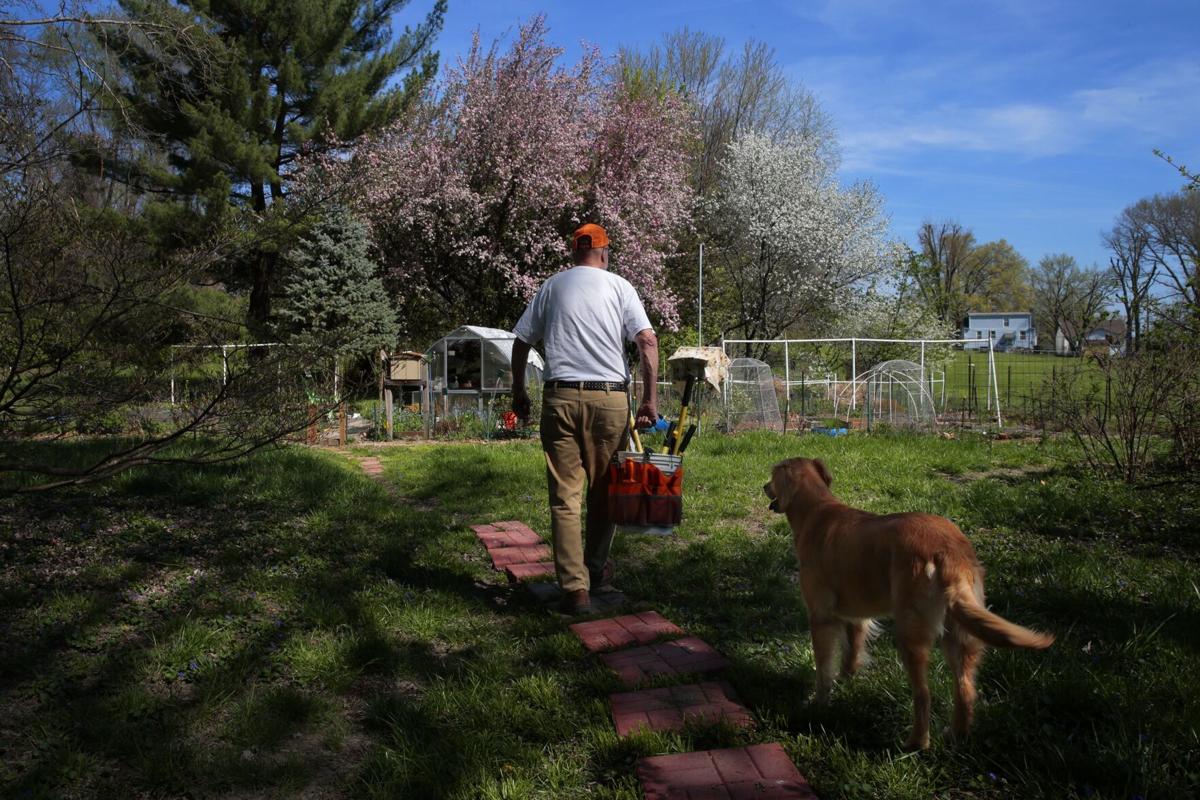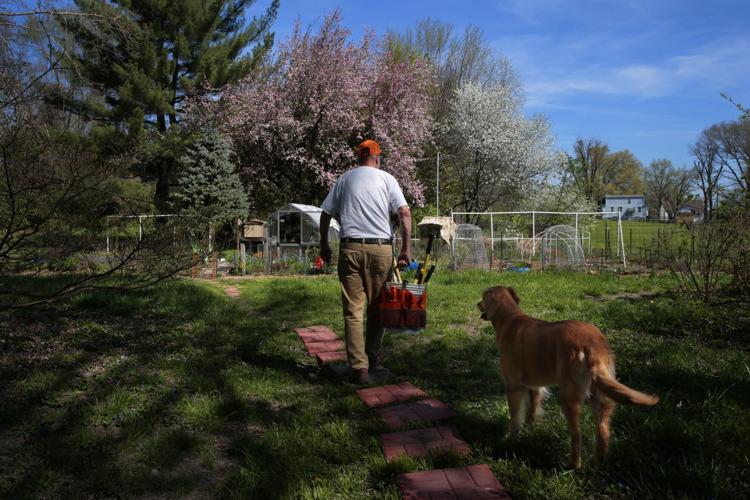ST. LOUIS COUNTY ÔÇö Over three decades, Bob Dye has slowly turned his Spanish Lake backyard into a nature preserve. Now heÔÇÖs hoping he can keep it that way.
The wooded lot is home to native plants, morel mushrooms, elderberries and honeybees. Persimmon, cherry, peach, plum and pawpaw trees are just starting to bud. A bed of purple violets spreads over most of the property, which measures just 22 yards wide and runs the length of one and a half football fields.
But DyeÔÇÖs property is under constant threat, he said. Non-native plants, especially the invasive honeysuckle, could easily destroy the habitat he has created.
ÔÇťItÔÇÖs a bad plant,ÔÇŁ said Dye, 79, a retired computer scientist who studied wildlife management in college and made botany his lifeÔÇÖs hobby.

Spanish Lake resident Bob Dye looks over his fence that separates his property from the honeysuckle growing wildly on his neighbor's side on Wednesday, April 12, 2023. Dye has written the Ëú╠Ď╩ËĂÁ County Council repeatedly in an attempt to get the invasive honeysuckle added to the county ordinance that cites residents who let their yards become overgrown with weeds.
Dye feels so passionately about honeysuckle that every Monday for years, he has sent an email to the County Council member representing him in District 4. Every 10th email, he copies the entire seven-member council. He has sent almost 90 in total now.
People are also reading…
Every email asks for the same thing: He wants the council to add invasive species to the ordinance that cites residents who let their yards become overgrown with weeds. Under his proposal, the county would consider invasives a public nuisance. And that means the county itself would be responsible for policing violators ÔÇö residents who, for instance, let honeysuckle grow out of control.
The countyÔÇÖs not interested. Such a task would be too big and too costly, said the countyÔÇÖs director of sustainability, Mandy La Brier, in an October letter to Dye and council members. The county health department would have to dedicate time and money to post violation notices, and the public works department would be mandated under county ordinance to mow and trim areas of ÔÇťchronic violators.ÔÇŁ
ÔÇťAn issue of this magnitude, large in scope and widespread throughout the metropolitan region, requires more than local government ordinance changes. Government is not able to tackle this issue alone,ÔÇŁ La Brier wrote.
DyeÔÇÖs representative on the council, Chair Shalonda Webb of unincorporated North County, agrees with the sustainability director, said Shonte Harmon-Young, WebbÔÇÖs legislative assistant.
ÔÇťItÔÇÖs just not feasible,ÔÇŁ Harmon-Young said.
DyeÔÇÖs not giving up.
ÔÇśIt degrades your entire habitatÔÇÖ
The county already considers ÔÇťnoxiousÔÇŁ vegetation a . The state of Missouri has designated 12 , and honeysuckle isnÔÇÖt on the list. The county could add invasive species, including honeysuckle, to its ordinance.
ÔÇťThe state of Missouri has a very clear definition of what invasive plants are, and IÔÇÖm just asking for a very slight change in the ordinance,ÔÇŁ Dye said. ÔÇťThey should be able to enforce it.ÔÇŁ

Spanish Lake resident Bob Dye, 79, weeds his asparagus bed in his garden on Wednesday, April 12, 2023.
There are at least seven invasive honeysuckle species documented in Missouri, according to the , and itÔÇÖs a particularly destructive nuisance. HoneysuckleÔÇÖs delicate yellow and white flowers radiate a sweet, alluring fragrance. The flowers create a beautiful contrast against the plantÔÇÖs emerald green foliage and juicy red berries.
But, over time, its impenetrable thicket of vines can take down trees. Honeysuckle grows before everything else in the spring, robbing water and nutrients, and preventing sunlight from reaching native vegetation, according to Jill Maes, an expert on honeysuckle with the Missouri Botanical Garden. It has to native habitats across Missouri, including in the Ëú╠Ď╩ËĂÁ region, and it impacts agriculture and the outdoor recreation industry. And it contributes to more illness because of increased tick and mosquito populations.
ÔÇťBiodiversity is very important for humans and animals, for the air you breathe,ÔÇŁ Maes said. ÔÇťWhen everything is taken over by just one plant, nature canÔÇÖt live off that. It eventually degrades your entire habitat.ÔÇŁ
Nonnative honeysuckle was from eastern Eurasia in the late 1800s for landscaping and erosion control, though its shallow roots didnÔÇÖt work very well for the latter, according to the University of Missouri. It wasnÔÇÖt until the mid-1980s that it was first recognized as invasive. It spreads easily, thriving in the Midwest climate.
Because of its destructive nature, several states, including Illinois, Indiana, Ohio, New York, Massachusetts and New Hampshire, have banned the sale or purchase of certain types of honeysuckle. ItÔÇÖs still readily available for purchase online and in garden shops in Missouri.
ÔÇśWhat else have I got to do?ÔÇÖ
La Brier said the county is dedicated to fighting invasive species, and suggested residents contact the Missouri Botanical Garden for information on and replace it with native or noninvasive plants. The county could also join the Missouri Invasive Plant Council, which seeks to stop the sale of invasive plants in Missouri, or participate in the .
County Executive Sam Page mentioned honeysuckle during comments at this weekÔÇÖs County Council meeting. He recognized two volunteers who have worked every Tuesday morning for the past two years clearing invasive honeysuckle from Faust Park in Chesterfield. James DeBoard and Conrad Scranton have managed to clear 29 acres over roughly 2,000 hours.

Spanish Lake resident Bob Dye, 79, takes time to cuddle with his golden retriever Dora as he weeds his asparagus bed in the garden behind his home on Wednesday, April 12, 2023. Besides growing vegetables and raising fruit trees, Dye's backyard stretches more than 500 feet from his back door. ÔÇťMy wife calls it our state park,ÔÇŁ he said.
ÔÇťOur volunteers play an integral role in keeping our parks beautiful,ÔÇŁ Page said Tuesday.
Volunteer work isnÔÇÖt enough for Dye. He is unwilling to relent on pursuing his main goal: anti-invasive-species legislation in Ëú╠Ď╩ËĂÁ County.
On a sunny spring day last week as he trudged through the back of his property, he zeroed in on a honeysuckle shoot that had sprouted near a wild holly sapling. He bent down, grabbed the shoot, and yanked it out.
ÔÇťWhat else have I got to do?ÔÇŁ he said.












